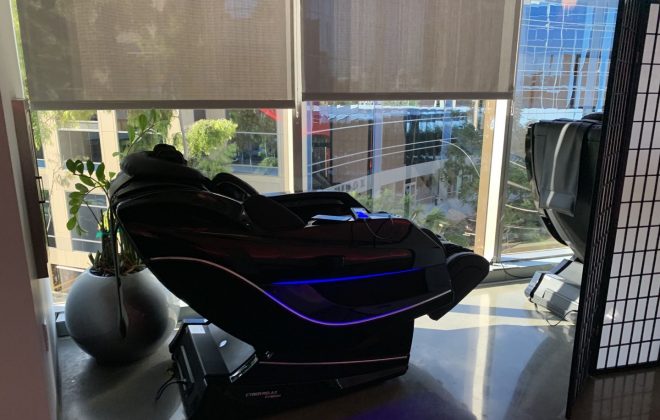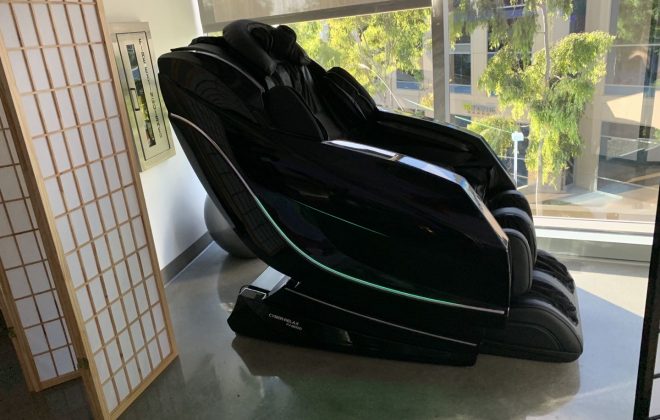Thoracic kyphosis associated with myofascial pain syndrome is a common clinical complaint. The objective of this article is to describe and discuss management of patients with thoracic kyphosis and associated myofasical pain syndrome using the Deep Muscle Stimulator device and exercise. Thoracic kyphosis is a very common dysfunction, especially as we get older. Sitting in a slumped posture coupled with a sedentary lifestyle can cause and perpetuate kyphosis and myofascial pain. As with most health conditions, prevention of kyphosis is easier than reversing the condition.
Kyphosis Treatment by Deep Muscle Stimulator & Exercise
Dr. Jeffrey Tucker
Diplomate American Chiropractic
Rehabilitation Board
11600 Wilshire Blvd. #412
Los Angeles, CA 9025
310-470-4511
www.DrJeffreyTucker.com
Thoracic kyphosis associated with myofascial pain syndrome is a common clinical complaint. The objective of this article is to describe and discuss management of patients with thoracic kyphosis and associated myofasical pain syndrome using the Deep Muscle Stimulator device and exercise. Thoracic kyphosis is a very common dysfunction, especially as we get older. Sitting in a slumped posture coupled with a sedentary lifestyle can cause and perpetuate kyphosis and myofascial pain. As with most health conditions, prevention of kyphosis is easier than reversing the condition.
Problems occur when the kyphotic curve becomes increased and is associated with stiffness. The thoracic spine is naturally the stiffest section of the spine, because of the rib attachments forming the costotransverse and costovertebral joints. The two main planes of movement are flexion/extension and rotation. The upper thoracic spine has a very
important relationship to the neck, scapula and shoulders. The mid thoracic spine has an important relationship with the diaphragm. The costal part of the diaphragm has slips of muscle arising from the internal surfaces of the inferior six ribs and their costal cartilages, interdigitating with the slips of the transverse abdominus. The thoracolumbar junction has a very important relationship to the lower back. It is important to assess exactly
where in the thoracic spine stiffness is taking place. Stiffness in the upper back with a rounded shoulder appearance is often associated with myofascial pain syndrome in the
upper and middle trapezius, rhomboids, pectorals, and levator scapulae muscles. These
muscles often feel very tight and overactive. Muscle dysfunction in this area can be from lower trapezius and/or serratus anterior muscle deficiency, muscle tension, muscle inhibition and myofascial trigger points.
The Deep Muscle Stimulator (DMS) developed by Dr. Jake Pivaroff, a chiropractor, is a hand held electric motorized device that provides brisk vibration and percussion in rapid succession. To the client it feels like strong vibration.
Like manipulation, the DMS influences mechanoreceptor stimulation which may inhibit pain, relax hypertonic muscles, and restore proper motion to restricted spinal joints. The DMS can be used as a stand alone treatment or in conjunction with any other modality or mobilization/manipulation technique. It is especially useful for neuro-myofascial techniques, and pre- or post-manipulation therapy. The author is currently using the DMS
in conjunction with Neuromobilization Techniques as well. The DMS technique causes mechanical contraction of muscle and is performed to treat neuromusculoskeletal conditions.
The DMS device is especially useful for covering the entire surface of the back. The brisk vibration and percussion delivered by the device provides pressure and force to overcome the density of the erector muscles, spinous ligaments and thoracolumbar fascia. I can cover more surface area using the DMS, be more thorough and faster, than using hands
alone. Although the patient usually reports feeling relaxed, the device has a stimulating effect upon the nerve receptors. A vibratory sensation is conveyed from the site of application on the body that travels outward for 2-4 inches or further, depending on the patients’ density. Latent trigger points, taut bands and/or tender spots that were not felt by the patient will often be revealed with a sensation when stimulated by the DMS, thus
allowing these spots to be worked out.
The body tissues directly influenced by the Deep Muscle Stimulator (DMS) are the skin, the fascia, the muscular system, lymphatic system, and the nervous system. The glandular, digestive, and bony systems are indirectly influenced. In cases of numbness or tingling, this vibration will have a benumbing effect which will react in a sedative manner. Like ischemic compression techniques, the DMS will reduce trigger point sensitivity found in muscle, tendon, periosteum, ligament and skin. By reflex action
through the sensory nerves in the skin a sedative effect is produced by DMS.
The muscles and soft tissues are bound together by the deep and superficial fascia, the viscous, gel-like ground substance, and layers of many large and small blood vessels. Metabolites and toxins can become stored in the connective tissues and the DMS will increase vasodilation, allowing tissues to receive adequate fresh amounts of oxygen and nutrients. This process will remove waste byproducts to facilitate tissue recovery and
repair. DMS can be lightly used over swollen joints in order to send on through the blood stream the broken down products of inflammation.
Specific treatment for thoracic kyphosis will include manipulation of hypomobile joints and DMS used over the soft tissues. Using the device can be performed in a stroking nature, in which the surface of the device is used lightly or with deeper stroking over the paraspinal musculature. The device provides a deep kneading as well as stroking. Holding the device slightly off the skin to provide light stroking is used in the early
stages of treatment or when deeper stroking cannot be tolerated by the client. Light stroking, even in its lightest form, has definite therapeutic effects. The device is used with a firm even pressure either in a transverse or circular manner. A definite amount of body surface should be decided upon by the operator before using the DMS. For example,
thorough stroking of the gastrocnemius/Achilles tendon and/or the hamstring muscle may be required to release tension that is causing a patient to curl forward contributing to thoracic kyphosis .
Deep Muscle Stimulator Technique for Kyphosis
Changing the relationships among the bones in an abnormal kyphotic spine requires changing the tensional balance through the soft tissues and actively moving the spine. To perform this procedure, the doctor will use the DMS device along the erector spinae muscles while the client performs active motion. Ask your client to stand close to a counter top so there hands can easily rest on the counter top and be used as a support. An
alternate position is to have the client sit on a stool or the edge of a treatment table making sure the feet are grounded on the floor. Have the client assume a “tall spine” posture. Instruct your client to drop the chin toward the chest until a comfortable stretch is felt. Allow the weight of the forehead to carry the thoracic spine into flexion one vertebrae at a time. Complete thoracic flexion and simultaneously treat the paraspinal
muscles with the DMS. Instruct the client to curve in the opposite direction, maintain moving the DMS along the paraspinal muscles. Maintain the pressure of the DMS as the client opens into hyperextension at the thoracic spine. Different forms of mobilization can be used with the DMS, coupled with passive and or active movements to joints. Manual stretching of myofascial trigger points, manual stretching of tissue and muscle
fascia, and manual separation of connective tissue can be performed while the operator is using the DMS over the involved tissue.
An office visit using the DMS device can include both manipulation of the joints and soft tissues, or without movements to the joints as a stand alone treatment with its own physiologic effects to the soft tissues. The DMS prevents or breaks down adhesions if tissues are bruised, matted, or thickened. DMS has a reflex action upon the nervous system by affecting the peripheral sensory nerves.
The dry rubbing over the back extensors is often associated with muscular contractions and when the treatment is stopped there is an obvious elevation of the local skin temperature. Patients appreciate that oil or lotion does not have to be applied.
Corrective Exercise
The types of exercises can be broken up into two categories. First, range of movement exercises aimed at increasing movement of the many joints that make-up the thoracic spine. Flexibility exercises into rotation, flexion and particularly extension are essential. I find the most useful exercise, is to use a high density foam roller, laying it cross the spine in the stiff hypomobile areas, knees bent up and then arching back over it as the most useful flexibility exercise.
The foam roll is used as an inhibitory technique to release tension and/or decrease activity of overactive neuro-myofascial tissues in the thoracic spine. The foam roll provides a very good maintenance flexibility routine and is best performed before stretching as a way to mobilize the joints. Other flexibility exercises that are important are stretches for the pectorals and latissimus dorsi. The static latissimus stretch is accomplished with the client on all fours with one arm outstretched, the hand and forearm
on a stability ball. Tightness through here can often pull the shoulders forward and increase the kyphosis. If someone is stiff and rounded through the thoracic spine, the upper trapezius, rhomboids and levator scapulae muscles are often very tight and overactive. The DMS
can be used over these muscles as well as over the latz and pectoralis muscles. The second group of exercises are to improve muscle tone and endurance and thus
posture. The better the muscles are at holding the thoracic spine in correct posture, the less stiff the thoracic spine will become. Key muscle groups are the lower trapezius, serratus anterior and thoracic erector spinae.
Gym based exercises that improve kyphosis are, back extension, bent over row and diagonal cable pulls. Performing isolated strengthening is a technique used to increase intramuscular coordination of specific muscles. With the chest on a stability ball and both toes touching the ground, the letters ‘Y’, ‘T’, ‘W’ and ‘L’ can be performed with the arms. Make sure you have your feet on the ground and if required have the feet up against
a wall, lay face down with the swiss ball positioned under your chest and stomach. You have to hold your thoracic spine extended while feeling like you are pushing your chest out, pulling the shoulders and scapulae away from your ears (“down and back”). Then make the letters with your arms and hold each position for two breaths. These postural stabilization exercises on the ball can be performed 3-5 days per week. One to two sets of
10-15 repetitions is suitable.
Abnormal kyphosis treatment objectives are: to decrease pain, strengthen weak muscles, decrease mechanical stress on spinal structures, improve fitness levels, induce intersegmental motion, improve posture and improve overall mobility.
In summary, assess client’s posture for dorsal kyphosis. Observe the thoracic spine during arm raising and lowering. Does the spine straighten or not? Apply manipulation to fixed segments, provide Deep Muscle Stimulator device over thoracic paraspinal muscles with active range of motion, instruct client in corrective exercises.
Example Exercise Prescription for Kyphosis:
Give patient advise on proper posture while sitting and standing. Teach clients to perform a sternal lift and “tall spine”.
Train proper respiration.
Deep Muscle Stimulator over the entire back.
Mobilization/manipulation of hypomomobile/fixed joints in the thoracic spine and ribs. Foam roll at home (daily). Stretch/lengthen the latissimus dorsi, upper trapezius, subscapularis, pectoralis (daily). Perform isolated exercises to the lower trapezius and serratus anterior. Perform integrated exercises: lunge to overhead press with free weights in the hands. Dr. Jeffrey Tucker is a rehabilitation specialist, lecturer and healer best known for his holistic approach in supporting the body’s inherent healing mechanisms and integrating the art and science of chiropractic, exercise, nutrition and attitudinal health. He will be teaching these methods of rehabilitation in courses sponsored by the Chiropractic Rehabilitation Association and NASM. For more information, please visit: www.drjeffreytucker.com.




